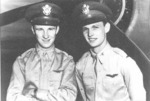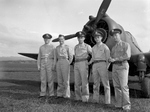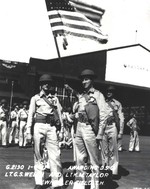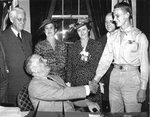George Welch
| Surname | Welch |
| Given Name | George |
| Born | 18 May 1918 |
| Died | 12 Oct 1954 |
| Country | United States |
| Category | Military-Air |
| Gender | Male |
Contributor: David Stubblebine
ww2dbaseBorn George Louis Schwartz, Jr., his name was changed due to anti-German sentiments from World War I. His parents gave George and his brother their mother's maiden name of Welch but retained Schwartz as George's middle name. Welch is often reported to have been heir to the Welch Grape Juice legacy, but the family has maintained that this is not true.
ww2dbaseGeorge Welch's father was a senior chemist for DuPont in Wilmington, Delaware, United States. George finished three years of a mechanical engineering program at Purdue University prior to enlisting in the Army Air Corps in 1939. He completed his flight training and in January 1941 he was assigned to the 47th Fighter Squadron on the island of Oahu in the Hawaiian Territory.
ww2dbaseOn Saturday evening, December 6, 1941, Welch and his wingman, Lt. Ken Taylor, attended a formal dinner-dance that led into an all-night poker game for the two fliers - not an unusual Saturday night for Welch and his wingman. Returning to their barracks near Wheeler Field in the center of the island shortly before dawn Sunday morning, both men were still wearing their tuxedo trousers when the area came under the Japanese aerial attack. Welch and Taylor had recently had their fighter planes moved to an outlying airstrip at Haleiwa so while Taylor got his Buick, Welch telephoned the air strip and screamed, 'Get two P-40s ready! It's not a gag - the Japs are here!' Driving at over 100 MPH and coming under Japanese strafing multiple times along the way, the two fliers arrived at Haleiwa to find their P-40 Warhawks fueled, idling, and being armed. Acting completely on their own initiative, Welch and Taylor took off and engaged the enemy. Taylor took off directly onto the tail of a Japanese plane and he began firing almost immediately, despite both planes only having ammunition in their wing-mounted .30 cal guns. The two successfully engaged several enemy aircraft before having to land at Wheeler Air Field to refuel and rearm. They returned to the air and successfully engaged the attacking Japanese aircraft once again, finishing the day with four confirmed kills for Welch, two for Taylor, and even more "damaged" and "probables" for the pair. These two pilots accounted for nearly 20% of all Japanese aircraft losses during the attack and two-thirds of all Japanese air-to-air losses.
ww2dbaseBoth Welch and Taylor were awarded the Army’s Distinguished Service Cross (DSC) for their efforts (the highest pure-Army decoration). Both were initially nominated for the Medal of Honor by AAF Chief "Hap" Arnold but because the two acted without orders, other "higher ups" downgraded the awards to the DSC. Welch's DSC citation takes about three times as much space to describe his heroism as any one of the 15 Navy Medal of Honor citations for actions that day.
ww2dbaseDSC Citation for Second Lt. George S. Welch
ww2dbaseGEORGE S. WELCH, Second Lieutenant , 47th Pursuit Squadron, 15th Pursuit Group, Air Corps, United States Army.
ww2dbaseFor extraordinary heroism in action over the Island of Oahu, Territory of Hawaii, and waters adjacent thereto, December 7, 1941. When surprised by a heavy air attack by Japanese Forces on Wheeler Field and vicinity at approximately 8 a.m., he left Wheeler Field and proceeded by automobile, under fire, to Haleiwa Landing Field, a distance of approximately ten miles, where the planes of his Squadron were stationed. He immediately, on his own initiative, took off for the purpose of attacking the invading Japanese aircraft in attacking force, and proceeded to his initial point over Barbers Point. At time of take off he was armed only with caliber .30 machine guns. Upon arrival over Barbers Point he observed a formation of approximately twelve planes over Ewa, about one thousand feet below and ten miles away. Accompanied only by one other pursuit ship, he immediately attacked this enemy formation and shot down an enemy dive bomber with one burst from three caliber .30 guns. At this point he discovered that one caliber.30 gun was jammed. While engaged in combat his plane was hit by an incendiary bullet, which passed through the baggage compartment just in the rear of his seat. He climbed above the clouds, checked his plane, returned to the attack over Barbers Point, and immediately attacked a Japanese plane running out to sea, which he shot down, the plane falling into the ocean. No more enemy plans being in sight he proceeded to Wheeler Field to refuel and replenish ammunition. Just as refueling and reloading were completed but before his guns had been repaired, a second wave of about fifteen enemy planes approached low over Wheeler Field. Three came at him and he immediately took off, headed straight into the attack, and went to the assistance of a brother officer, who was being attacked from the rear. This enemy plane burst into flames and crashed about half way between Wahiawa and Haleiwa. During this combat his plane was struck by three bullets from the rear gun of the ship he was attacking. One striking his motor, one the propeller and one the cowling. This attack wave having disappeared, he returned to the vicinity of Ewa and found one enemy plane proceeding seaward, which he pursued and shot down about five miles off shore, immediately thereafter returning to his station at Haleiwa Landing Field. Lieutenant WELCH'S initiative, presence of mind, coolness under fire against overwhelming odds in his first battle, expert maneuvering of his plane, and determined action contributed to a large extent toward driving off this sudden unexpected enemy air attack.
ww2dbaseAfter the Pearl Harbor attack, Welch toured the United States supporting War Bonds before being assigned to the Eighth Army Fighter Squadron in New Guinea flying the P-39 Airacobra. Welch was very outspoken about his dislike for the P-39 and made numerous requests for transfer to squadrons flying the P-38 Lightning. His requests were ultimately granted and Welch flew P-38’s with the 80th Fighter Squadron. Welch finished the war with 348 combat missions, 16 confirmed kills, and a case of malaria.
ww2dbaseEven before the war ended, Welch began working as a test pilot for North American Aviation, a job he held for the rest of his life.
ww2dbasePersuasive evidence exists that Welch broke the sound barrier in a prototype P-86 Sabre one week before Chuck Yeager’s historic X-1 flight. Welch's press past mach 1 was in a dive while Yeager's was in level flight, so history remembers Yeager.
ww2dbaseWelch tested many of the first jet prototypes and even trained Air Force pilots on combat missions in Korea. Welch was reported to have downed several enemy aircraft during this "training," but since he was a non-combatant, formal credit for those kills went to the "students."
ww2dbaseWhile testing the YF-100 Super Sabre, Welch again exceeded mach 1 multiple times beginning May 25, 1953. On October 12, 1954, Welch’s YF-100 came apart during a 7g pull-out at mach 1.55. Welch survived the ejection but died shortly after arriving at the hospital.
ww2dbaseWelch is buried at the Arlington National Cemetery in Virginia, United States. His military decorations include: the Distinguished Service Cross, the Silver Star, the Distinguished Flying Cross, the Air Medal, the American Defense Medal, the Asiatic-Pacific Campaign Medal with four Battle Stars, and the Presidential Unit Citation.
ww2dbaseSources: Arlington National Cemetery; Ace Pilots; Aviation History; Ken Taylor – The Reluctant Hero; The Amazing George Welch; Wikipedia.
Last Major Revision: Jul 2008
George Welch Interactive Map
Photographs
 |  |  |  |
George Welch Timeline
| 18 May 1918 | George Welch was born. |
| 1 Oct 1947 | XP-86 prototype jet fighter flew for the first time at Muroc Field, California, United States with George Welch in the cockpit. |
| 12 Oct 1954 | George Welch passed away. |
Did you enjoy this article or find this article helpful? If so, please consider supporting us on Patreon. Even $1 per month will go a long way! Thank you. Share this article with your friends: Stay updated with WW2DB: |
Visitor Submitted Comments
11 May 2009 04:40:44 PM
George Welch became an ace shooting down (5) Japanese aircraft Dec. 7, 1941.
22 Nov 2009 03:47:38 AM
Hello,
Do you know the exact day of promotion of George S. Welch to 2nd Lt, 1st Lt, Capt and also Maj.
I am interested in US Aces and unfortunately the data and details about them are not mentioned by Frank Olynyk in his book Stars and Bars.
Cordially Zdenek Kocab
21 Mar 2023 11:10:28 AM
I work at Major George S. Welch Elementary and am wondering if George has any family members alive that would like to connect because we are honoring him at a school assembly.
30 Jan 2024 03:11:46 PM
Hey! Relative of George Welch here. There are still some of us alive, my grandfather, Georges nephew, had passed away a year ago. Both George's sons are alive but hardly do anything relating their father. This is return for S.Rosa.
All visitor submitted comments are opinions of those making the submissions and do not reflect views of WW2DB.
» Attack on Pearl Harbor
Related Books:
» Pearl; December 7, 1941
- » 1,150 biographies
- » 337 events
- » 43,917 timeline entries
- » 1,241 ships
- » 350 aircraft models
- » 207 vehicle models
- » 374 weapon models
- » 123 historical documents
- » 260 facilities
- » 470 book reviews
- » 28,544 photos
- » 432 maps
George Patton, 31 May 1944
Please consider supporting us on Patreon. Even $1 a month will go a long way. Thank you!
Or, please support us by purchasing some WW2DB merchandise at TeeSpring, Thank you!
21 Jan 2009 04:55:14 AM
looking for my granddad jack paul welch, who served as us navy warrant officer during ww2. he, together with 2 other officers john and leonard, met my grandmom on a raft from cagayan de oro to mambajao, camiguin island(misamis oriental), philippines.the ggrandmom gave birth to my father in august 1946. she is now 83. i hope you can help me. dad is already 62 and still searching.
thank you.
mann